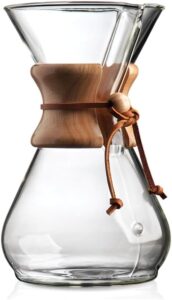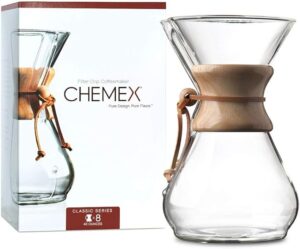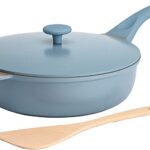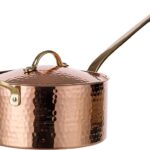Decoding the Magical Artistry of Chemex vs. Hario V60: which one Suits You Best?

Ah, the enchanting world of pour-over coffee! Ever wondered what sets apart a Chemex pour-over from a Hario V60? From the sleek design of the Chemex to the spiral ridges of the Hario V60, we’re about to uncover the secrets behind these brewing behemoths.
Table of Contents
Before we go through the nitty-gritty of brewing, let’s take a moment to appreciate the science behind the magic. You see, pour-over coffee isn’t just about caffeine kicks and bold flavors; it’s a delicate dance of extraction and infusion, where water temperature, grind size, and brewing time converge to create the perfect cup.
I remember the first time I laid eyes on a Chemex, its elegant hourglass silhouette and wooden collar calling out to me like a siren song. With trembling hands, I started my pour-over journey, navigating the intricacies of bloom and pour with the grace of a caffeinated ballet dancer. And oh, the taste! It was like sipping sunshine from a cup, each sip a revelation of floral notes and caramelized sweetness.
But then came the Hario V60, with its minimalist design and cult following. Intrigued by its reputation for clarity and precision, I found myself on a new brewing adventure, armed with nothing but a cone-shaped dripper and a sense of curiosity. And let me tell you, the first sip was nothing short of revelatory. The coffee sang on my palate, each note crisp and clear, a symphony of acidity and sweetness that left me craving more.
Chemex and Hario V60
Let’s explore the rich history and intricate design of these iconic brewing methods.
The Chemex: A Timeless Elixir
First, let’s journey back to 1941 when chemist Peter Schlumbohm introduced the world to the Chemex. With its elegant hourglass shape and sleek glass construction, the Chemex is not just a coffee maker but a timeless piece of art. Its thick paper filters ensure a clean, sediment-free cup, allowing the true flavors of the coffee to shine through.
Order Your Chemex Pour-Over Coffeemaker Now
The Hario V60: Innovation in a Cone
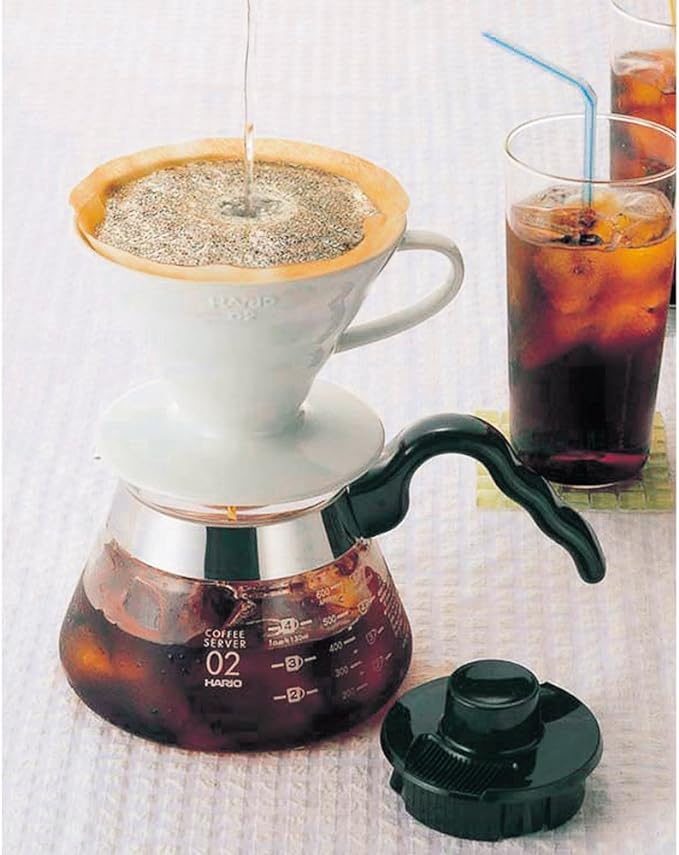
Now, fast forward to 2004, when the Hario V60 made its debut and revolutionized the coffee world. With its minimalist cone-shaped dripper and signature spiral ribs, the V60 is a marvel of Japanese design. Its spiral ridges promote an even extraction, resulting in a consistently delicious brew every time.
Order Your Hario V60 Pour-Over Coffeemaker Now
Unique Brews, Unique Features
But what makes these brewing methods unique? While the Chemex offers a larger brewing capacity and a thicker filter for a cleaner cup, the V60 provides more control over the brewing process, allowing coffee enthusiasts to experiment with various parameters to achieve their perfect brew. It’s a fascinating clash between tradition and innovation, and we’re here to delve into every aspect of this captivating debate.
The Art of Brewing: Chemex vs. Hario V60
How about the intricate brewing processes of these iconic methods and their unique charms?
Mastering the Chemex Technique
Brewing with the Chemex is an art form in itself. The process begins with pre-wetting the paper filter to remove any paper taste and preheating the vessel to maintain optimal brewing temperature. Then, it’s all about the bloom – pouring a small amount of hot water over the coffee grounds to release trapped gases and kickstart the extraction process. From there, it’s a slow and steady pour in concentric circles, ensuring even saturation of the grounds and a uniform extraction.
Order Your Chemex Pour-Over Coffeemaker Now
Unraveling the Mysteries of the Hario V60
Meanwhile, brewing with the Hario V60 is a delicate dance of water and coffee. The process starts with rinsing the paper filter to eliminate any paper taste and preheating the dripper and vessel. Then, it’s time for the bloom – a quick pour of hot water to saturate the grounds and allow them to degas. Next comes the main pour, where hot water is added in controlled pulses, creating turbulence and ensuring an even extraction. With the V60, it’s all about precision and finesse, dialing in the grind size, water temperature, and pour rate to achieve the perfect brew.
Order Your Hario V60 Pour-Over Coffeemaker Now
A Clash of Techniques
While both methods share similarities in their brewing processes, they also have distinct differences that set them apart. The Chemex’s thick paper filter yields a clean, sediment-free cup, while the V60’s thinner filter allows more oils and fines to pass through, resulting in a richer, more nuanced brew. Additionally, the Chemex’s hourglass shape and thick walls provide excellent heat retention, while the V60’s cone-shaped design promotes better water flow and extraction. It’s a fascinating juxtaposition of techniques, each with its own merits and complexities, and we’re here to unravel them all.
Exploring Flavor Profiles
Chemex’s Flavor Symphony
Brewing with the Chemex yields a cup of coffee that is characterized by its clarity and brightness. The thick paper filter removes oils and sediment, resulting in a clean and crisp brew. The Chemex accentuates the delicate flavors of the coffee beans, allowing subtle notes of fruitiness, floral tones, and acidity to shine through. With its smooth mouthfeel and well-balanced profile, a Chemex-brewed coffee is a true symphony of flavors.
Hario V60’s Flavor Expedition
On the other hand, the Hario V60 offers a more nuanced and complex flavor experience. Its thinner paper filter allows more oils and fines to pass through, resulting in a fuller-bodied cup with greater depth and richness. The V60 accentuates the bold and intense flavors of the coffee beans, delivering a brew that is characterized by its robustness and complexity. With its vibrant acidity, pronounced sweetness, and lingering finish, a V60-brewed coffee is a captivating journey for the taste buds.
Weighing the Pros and Cons
Advantages of Chemex
- Clean and Crisp Brew
One of the key advantages of the Chemex brewing method is its ability to produce a clean and crisp cup of coffee. The thick paper filter removes oils and sediment, resulting in a smooth and clear brew that accentuates the delicate flavors of the coffee beans.
- Elegant Design and Aesthetic Appeal
Another advantage of the Chemex is its elegant design and aesthetic appeal. With its sleek glass carafe and timeless hourglass shape, the Chemex is not only a functional brewing device but also a beautiful piece of art that adds a touch of sophistication to any kitchen.
- Large Brewing Capacity
Additionally, the Chemex boasts a large brewing capacity, making it ideal for serving multiple cups of coffee at once. Whether you’re hosting a brunch with friends or enjoying a lazy Sunday morning with family, the Chemex has you covered with its generous capacity.
Disadvantages of Chemex
- Requires Special Filters
One of the drawbacks of the Chemex brewing method is that it requires special proprietary filters, which can be expensive and sometimes difficult to find. While these filters contribute to the Chemex’s clean brew, they add an extra cost and inconvenience for users.
- Longer Brew Time
Another disadvantage of the Chemex is its longer brew time compared to other brewing methods. The Chemex’s thick paper filter slows down the brewing process, requiring patience and careful attention to achieve the perfect extraction.
Advantages of Hario V60
- Enhanced Flavor Extraction
One of the major advantages of the Hario V60 is its ability to extract more flavor from the coffee beans. The V60’s thinner paper filter allows more oils and fines to pass through, resulting in a fuller-bodied cup with greater depth and complexity of flavor.
- Faster Brew Time
Additionally, the Hario V60 offers a faster brew time compared to the Chemex, making it a popular choice for busy mornings or on-the-go coffee enthusiasts. With its efficient brewing process, the V60 delivers a delicious cup of coffee in record time.
Disadvantages of Hario V60:
- Requires Precision and Skill
One potential drawback of the Hario V60 is that it requires more precision and skill to master compared to other brewing methods. Achieving the perfect extraction with the V60 requires careful attention to variables such as grind size, water temperature, and pouring technique.
- Limited Brewing Capacity
Another disadvantage of the Hario V60 is its limited brewing capacity, which may not be sufficient for serving multiple cups of coffee at once. While the V60’s compact size makes it convenient for single-serving brews, it may not be suitable for larger gatherings or sharing with guests.
Read More:
Brew-tiful Beginnings: Top 3 Espresso Machines for Coffee Enthusiasts!
Unveiling the Best Coffee Makers to Kickstart Your Mornings in 2023!


